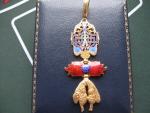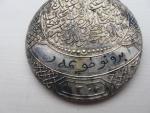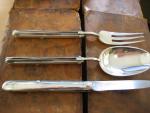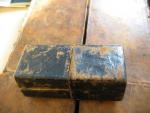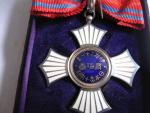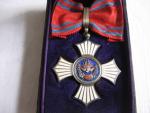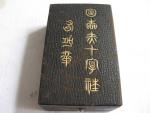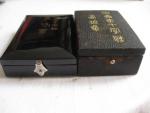-
Posts
663 -
Joined
-
Last visited
Content Type
Profiles
Forums
Blogs
Gallery
Events
Store
Everything posted by Josef Rietveld
-
an eyecatcher... josef
-
Thanks for this very informative input, looks as there are many things to find out. In the future we will maybe collect japanese ODMs by maker. haynau
-

Order of the Golden Fleece
Josef Rietveld replied to Antonio Prieto's topic in Rest of the World: Militaria & History
I tried the google translator to be sure but i already stumbled across this word during my research. Vellocino in Spanish means fleece, toison or Vlies as we say in German. regards Josef -

Turkey Engraving on Imtiyaz-Medal-Backside
Josef Rietveld replied to Josef Rietveld's topic in Turkey
dave, kapten windu and owain, thanks for your contribution, so to subsumme the postings the engravings read as: Bruno "To__er" or "Tu__er"; Thumhar or Tweemahr So it could easily be Trommer-Pashas medal but we will never know for sure? regards josef -

Order of the Golden Fleece
Josef Rietveld replied to Antonio Prieto's topic in Rest of the World: Militaria & History
Hi Hugh, thanks for your input, Your piece dates from 1980, btw do you have better pictures? Do you remember if this was the ONLY typ/variant cejalvo was offering at this time or could you choose? Have you been to the shop? regards josef -

Order of the Golden Fleece
Josef Rietveld replied to Antonio Prieto's topic in Rest of the World: Militaria & History
And there is a third Variant that i know from Gritzners Order Book and from auctions where it is described as 19th Century piece (see picture) So i guess none of them is nowadays a official one, because one of the other producers, besides cejalvo, you linked to this thread,offers a completely different fleece neckdecoration for 3300 Euros. regards Josef -

Order of the Golden Fleece
Josef Rietveld replied to Antonio Prieto's topic in Rest of the World: Militaria & History
Dear Antonio, thanks for your explanations. Sorry, but there is something i don't understand. When you look at the pictures when king Juan Carlos awards the Order of the golden fleece to Solana and García de la Concha you see that they get the collar and a miniature but NO neckdecoration to wear 'every day'. see picture 5 Award ceremony 2010 I try to figure out what the current neckdecoration looks like but it seems that there is no regulation for that and every knight can buy a fleece whatever he wants. For example the King himself wears a neckdecoration similar (but much more luxurious) to the one cejalvo produces (see picture). The other type you showed is also wellknown and looks similar to the one awarded to Prince Albert, Queen Victorias Husband (see picture). josef -

Turkey Engraving on Imtiyaz-Medal-Backside
Josef Rietveld replied to Josef Rietveld's topic in Turkey
That could easily be, i did a quick search on the web and even found Trümmer-Pasha instead of Trommer. Here is another pic. josef -

Turkey Engraving on Imtiyaz-Medal-Backside
Josef Rietveld replied to Josef Rietveld's topic in Turkey
Dear Dave thanks, i'am really impressed by your abbilities. When did you learn reading High-Arabic? Bruno Trommer as recipient would be great. The surname bruno is generally not very common. There can't be many brunos who got an imtiyaz. josef -

Order of the Golden Fleece
Josef Rietveld replied to Antonio Prieto's topic in Rest of the World: Militaria & History
Dear Antonio, it took me some time to response to your original thread. I have some questions. In 2010 two new entries to the spanish branch of the order of the golden fleece were published: Javier Solana and Víctor García de la Concha Now my questions. Am i right, that the fleece you show at the beginning of the thread is the version given in the franco-period? I ask because i got one that i guess is the current version (see picture). It is made by cejalvo/madrid and shows silvermarks (925) and makers mark. It did some internet-research and found pics from the 2010 awarding ceremony. It looks like as the the two new members only got the collar plus fleece pendant and a miniature but NO insignia to wear arround the neck. Is this correct? Do they have to buy the neckdecoration - if they want one - at their own costs? Is the cejalvo-fleece an official version or just one everybody can buy at the cejalvo-jewellers-shop? thanks in advance josef thanks -
Dear Turkey-Experts, I have a silver imtiyaz-medal with name-engraving in the backside-cartouche. Is anybody able to read/translate the name written there? regards and thanks in advance Josef
-

Austria-Hungary Order of the Iron Crown 3 kl
Josef Rietveld replied to Thierry's topic in Austro-Hungarian Empire
I have seen it on ebay, have i? i remember i didn't appreciate the rough way the wardecoration (laurel wreath) is fixed to the eagles wings. regards josef -

EXAMPLES FOR SILVER
Josef Rietveld replied to Mervyn Mitton's topic in Non Military Collectibles & Antiques
-

EXAMPLES FOR SILVER
Josef Rietveld replied to Mervyn Mitton's topic in Non Military Collectibles & Antiques
Mervyn i love your thread. Here is my personal favorite. A travel cutlery set dating from the 1780ies that i already presented here in 2007. I guess, i'am allowed to show it again in 2011. The set is made of silver and hallmarked with the viennas crest and the numbers 1 7 8 6 arround the crest for the year 1786. There are two makers marks "CF" and "IS". Only fork and spoon are hallmarked, the knife, as it was made of silver and steel (blade) has no marks. Overall length is abbout 17 cm. the complete set has a weight of 155 gramms. all handles show an engraved "R" for Reisinger. Biographic Details: the full name of the family is Reising von Reisinger. Maximilian von Reisinger, born 1776, entered service on the 9th of June 1790 and became ensign in the 12th k.k. Infantry-Regiment. He saw action at the campaigns from 1792 to 1815 and 1821 (naples?), took part in the siege of Mainz 1794 and the battles of Wagram (5/6th July 1809) and Aspern (21/22th May 1809) where he distinguished himself and was wounded. On 20th of April 1826 he was promoted to General-Major, 1833 to Feldmarschall-Leutnant (General-Lieutenant). 1840 he became holder of the 18th Infantery Regiment. He died on 28th of february 1848. He had only two decorations. The Army-Cross or socalled kanonenkreuz 1813/14 and the Commanders Cross of the Order of St. George of the Reunion (Sicilly). Possibly for the 1821-campaign. He just missed the Sevicecrosses which were founded in 1849. His Grandfather Joseph Reisinger was Feldstuck-Hauptmann and was nobled in 1731 by Charles VI. His father Maximillian von Reisinger died as General-Major. In 1845 the family was enobled to Freiherrn-Stand (baron), based on a regulation from Empress Maria Theresia from 1759 that after 30-years-of-service an officer could pled for an nobility-"upgrade". Feldmarschall-Leutnant von Reisinger was married to Josepha, maiden-name Gabriel, who gave birth to six children. IF ANYBODY HAS AN PRINT of Maximillian von Reisinger I would be very pleased to get PN. -
well, that is a point. You think the soldiers history is lost, cause nobody will look it up in the future when the medal doesn't exist any longer. Now i see your problem. But i think it is a special british problem. Most of our medals are nameless. After the collapse of the old empire 1918 a lot of the records were scattered, other records have been destroyed during and after WWII. So a part of our soldiers history is already gone. You still have the records. josef
-
Dear Club members, i followed this thread over the last weeks but have to act as a advocatus diaboli now. I really don't see the problem. Because what will happen. JimZ already wrote it: So the number of very common medals will be reduced and their price will rise untill ist is higher then the silver value. For example in Austria the number of small bravery medals (with exact the same weight as the large Bravery medal = 30 gramms) on the market will surely decrease. But we really have plenty of them. The issued more then 580.000, most of them struck in real silver. Lets say 300.000 survived till today. It don't fear if another 100.000 will disappear. BTW this happend so many times in history (coins, medals, silverware), I'am not afraid of this. Now you can get a worn bravery medal 2nd class without ribbon for approx. 12 to 15 euro. In five years the will maybe cost 30 or 40 euro and..... I own a heavy damaged swedish wasa order in 750/1000 Gold and i really think of bringing it to the refinery if the goldprice is increasing further on. There are so many of them in perfect condition, why it is forbidden to melt down a ruined one? Just because it is a historical item. Brrrrrrrrr.... I already sold arround 1000 gramms heavy worn and partially holed british sixpence, shillings, florins and halfcrowns (some 925/1000, some 500/100 fineness) and another 250 dutch silver guilders from the 1950ies and early 1960ies and i don't feel guilty at all. The british crowns i kept BTW. You know what Frederic II of Prussia said: who wants to preserve everything, preserves nothing Of course there are a lot of historic more important ODM's that will be melt down. But this also happend before.I don't even want to know what went to the refineries in the last decades.
-

Austria-Hungary Golden Fleece order - maker?
Josef Rietveld replied to Xtender's topic in Austro-Hungarian Empire
lets try this one Ebay josef -

Austria-Hungary Golden Fleece order - maker?
Josef Rietveld replied to Xtender's topic in Austro-Hungarian Empire
800 ist not an austrian hallmark. 800 is classiscal german for silver. so i think this fleece is made of gilded silver and german made. josef -

Major Friedrich Wilhelm Heinz in 1/6 scale
Josef Rietveld replied to ColinRF's topic in Military Art
me too josef -
Hi Dieter, glad you like it as i do. I have three jrc silver-crosses (old, taisho (?) and post 1945) and tried to compare the enamel quality. Just from the enamel i can't see big differences on the front side. The big difference is the backside. The old cross shows thicker enamel then the others. The enamels surface is not completely plain. It seems as when the kanji-characters are a bit like tent poles and the enamel is the tarp stretched on the poles. I hope this is understandable. I guess they needed some time to get to know how to make real good enamel. regards josef PS: i will keep ypur name in mind if i ever decide to sell this one
-
-
-
-
Here is another early one on womans bow. The kanji seems similiar to the last one shown by dieter. Which one is older? I guess mine. The boxcoverage is made of leather. The box itself is higher than pieces in laquerbox. regards josef
-

Austria-Hungary Gold Merit Cross with Crown
Josef Rietveld replied to Iver's topic in Austro-Hungarian Empire
doubleposting PLEASE DELETE !!







